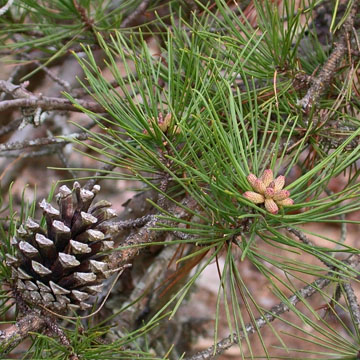

Pinus echinata - (image 1 of 5)
Taxonomy
Family: Pinacea
Habitat
Dry sandy or rocky soil.
Associates
Distribution
Southern NY to northern FL, west to southern OH, southern MO, eastern OK, and eastern TX.
Morphology
Upright, evergreen conifer to 35 m; bark scaly and nearly black in young trees, becoming red-brown and scaly-plated in age, often with small resin blisters; twigs pale and glaucous; winter buds less than 1 cm, red-brown to gray-brown, not strongly resinous; leaves fascicles of 2 or 3, persistent 2-4 years, soft, dark green, 7-12 cm long and about 1 mm thick; cones divergent, ovoid to ovoid-conic, 4-6 cm, opening at maturity but persisting several years; apophysis somewhat elevated, the umbo low-pyramidal, with a stout or slender, recurved or spreading spine 1-2 mm; seeds about 2 cm long.
Notes
Flowers NA
Wetland indicator: NA
Also called yellow pine. Can be somewhat difficult to identify because the needles are usually produced in bundles of both 2's and 3's on a single tree. The presence of resin blisters in the bark can be useful to distinguish this species from other pines.
References
Gleason, Henry A. and A. Cronquist. 1991. Manual of Vascular Plants of Northeastern United States and Adjacent Canada. Second Ed.
The New York Botanical Garden. Bronx, NY
USDA, NRCS. 2002. The PLANTS Database, Version 3.5 (http://plants.usda.gov).
National Plant Data Center, Baton Rouge, LA 70874-4490 USA.
|
Michael Hough © 2018 |